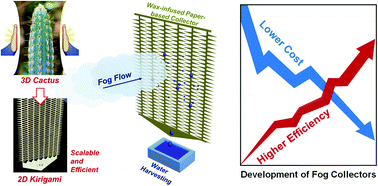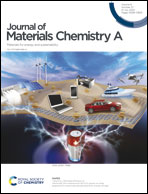Cactus kirigami for efficient fog harvesting: simplifying a 3D cactus into 2D paper art†
Abstract
Harvesting atmospheric water is a promising method for solving the water crisis in undeveloped regions, possessing remarkable advantages such as the use of simple structures, energy independence, low cost, etc. Cactus spines with a conical shape are able to achieve efficient water harvesting, but the fabrication of such a three-dimensional structure is complicated and tedious. Here we simplify cactus-inspired fog collecting spines from a 3D cone to a 2D triangle by designing a cactus kirigami. The wax-infused kirigami with anisotropic shape can reproduce the function of cactus spines, i.e., the efficient capture of fog droplets and rapid refreshing of the collecting interface through directional droplet self-propulsion. Fluid simulations suggest that the thinner spine with a small apex angle gives a higher onward flow speed for better fog capture. On the basis of the promising functions and the simplified structure, the cactus kirigami can be scaled up. Under a fog flow of ∼220 cm s−1, the water harvesting rate of cactus kirigami can reach ∼4000 mg cm−2 h−1, which is 1.6 and 11 times the rates of harp-like and plate collectors, respectively. Furthermore, the cost of this paper-based substrate and the construction process is largely reduced to nearly 0.5 $ per m2. This work provides a rational design for advanced fog harvesters, and should unlock more possibilities to develop functional materials from 3D to 2D for microfluidics, condensation, liquid collection, etc.



 Please wait while we load your content...
Please wait while we load your content...